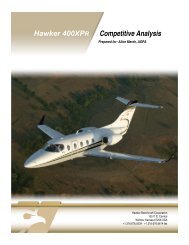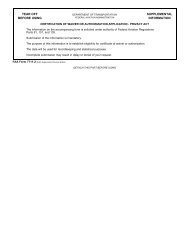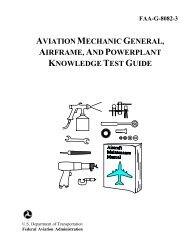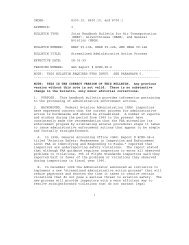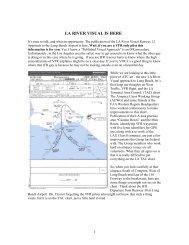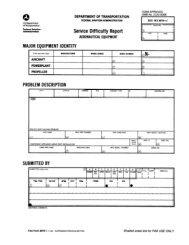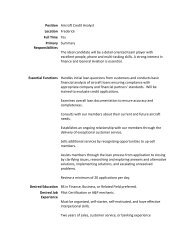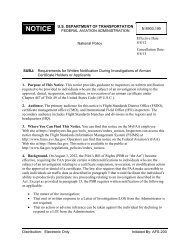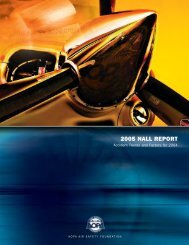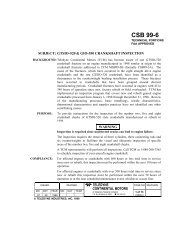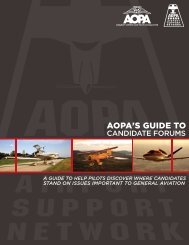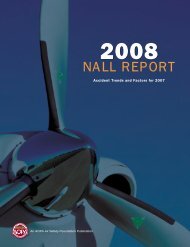Joseph T. Nall Report - Aircraft Owners and Pilots Association
Joseph T. Nall Report - Aircraft Owners and Pilots Association
Joseph T. Nall Report - Aircraft Owners and Pilots Association
You also want an ePaper? Increase the reach of your titles
YUMPU automatically turns print PDFs into web optimized ePapers that Google loves.
Accident Factors<br />
F A T A L<br />
MANEUVERING FLIGHT 126 TOTAL/64 FATAL<br />
Maneuvering flight continues to be one of the<br />
largest producers of fatal accidents. It is also one of<br />
the most preventable. Thirty-two of 64, or 50 percent,<br />
of fatal maneuvering accidents were the<br />
result of “hit terrain, wires, trees, etc.” Sixteen of<br />
the 64 (25 percent) fatal maneuvering accidents<br />
were attributed to “loss of control.” Two of the<br />
three fatal maneuvering accidents in multiengine<br />
airplanes were due to this cause.<br />
Some of these accidents occurred during legitimate<br />
activities such as aerial applications, banner<br />
towing, <strong>and</strong> law enforcement. These operations<br />
require low, slow flight <strong>and</strong> considerable missionrelated<br />
division of attention. In operations where<br />
there is a mission beyond just operating the aircraft,<br />
the task dem<strong>and</strong>s of the mission <strong>and</strong> the task<br />
dem<strong>and</strong>s of flying can reach extremes simultaneously,<br />
severely taxing the pilot’s capability. These<br />
operations carry some inherent risk <strong>and</strong> dem<strong>and</strong><br />
skill <strong>and</strong> vigilance from the pilot.<br />
More often than not, maneuvering accidents<br />
occurred during personal (65.1 percent), not<br />
mission-related, flights.<br />
A few of these accidents were the result of inadvertent<br />
loss of control by pilots performing common<br />
operations. Some, however, occurred during<br />
buzzing or low-level aerobatics. Many involved a<br />
degree of recklessness that makes it difficult to<br />
term them “accidents” in a true sense. No increase<br />
in proficiency can prevent such accidents. <strong>Pilots</strong><br />
must refrain from this type of reckless activity <strong>and</strong><br />
encourage their peers to do the same.<br />
Hit Terrain/<br />
Wires/Trees<br />
Lost Control<br />
Aerobatics<br />
Power Loss/<br />
Fuel Mismanagement<br />
Percent<br />
20<br />
16<br />
12<br />
8<br />
4<br />
0<br />
Percent<br />
100<br />
80<br />
60<br />
Alcohol/Drugs<br />
6.3%<br />
1996<br />
2.1% (1)<br />
0.0% (0)<br />
0.0% (0)<br />
2.1% (1)<br />
0.0% (0)<br />
0.0% (0)<br />
Fatal Maneuvering Accidents<br />
23.4% (11)<br />
21.4% (3)<br />
0.0% (0)<br />
53.2% (25)<br />
42.9% (6)<br />
33.3% (1)<br />
19.1% (9)<br />
35.7% (5)<br />
66.7% (2)<br />
Fixed<br />
Retractable<br />
Multi<br />
0 20 40 60 80<br />
Percent<br />
17.4%<br />
Maneuvering Accidents<br />
7.6%<br />
1997<br />
19.0%<br />
8.0%<br />
1998<br />
18.5%<br />
Fatal Maneuvering Accidents<br />
Type of Operation<br />
7.4%<br />
1999<br />
20.0%<br />
Other<br />
Total<br />
Fatal<br />
Personal<br />
Aerial<br />
Application<br />
Instructional<br />
Public Use<br />
Business<br />
40<br />
20<br />
0<br />
Hit Terrain/<br />
Wires/Trees<br />
Lost<br />
Control<br />
Aerobatics Power Loss/<br />
Fuel Mismanagement<br />
Alcohol/<br />
Drugs<br />
19



